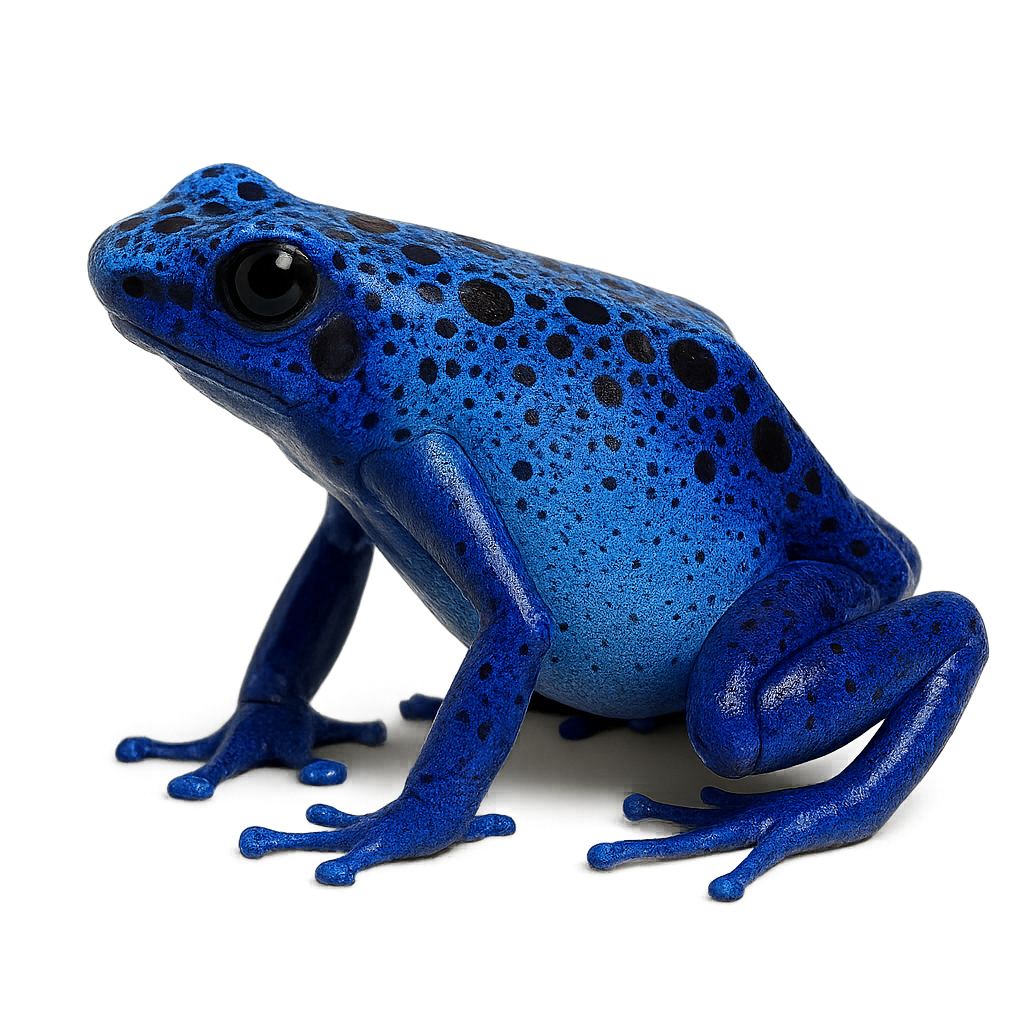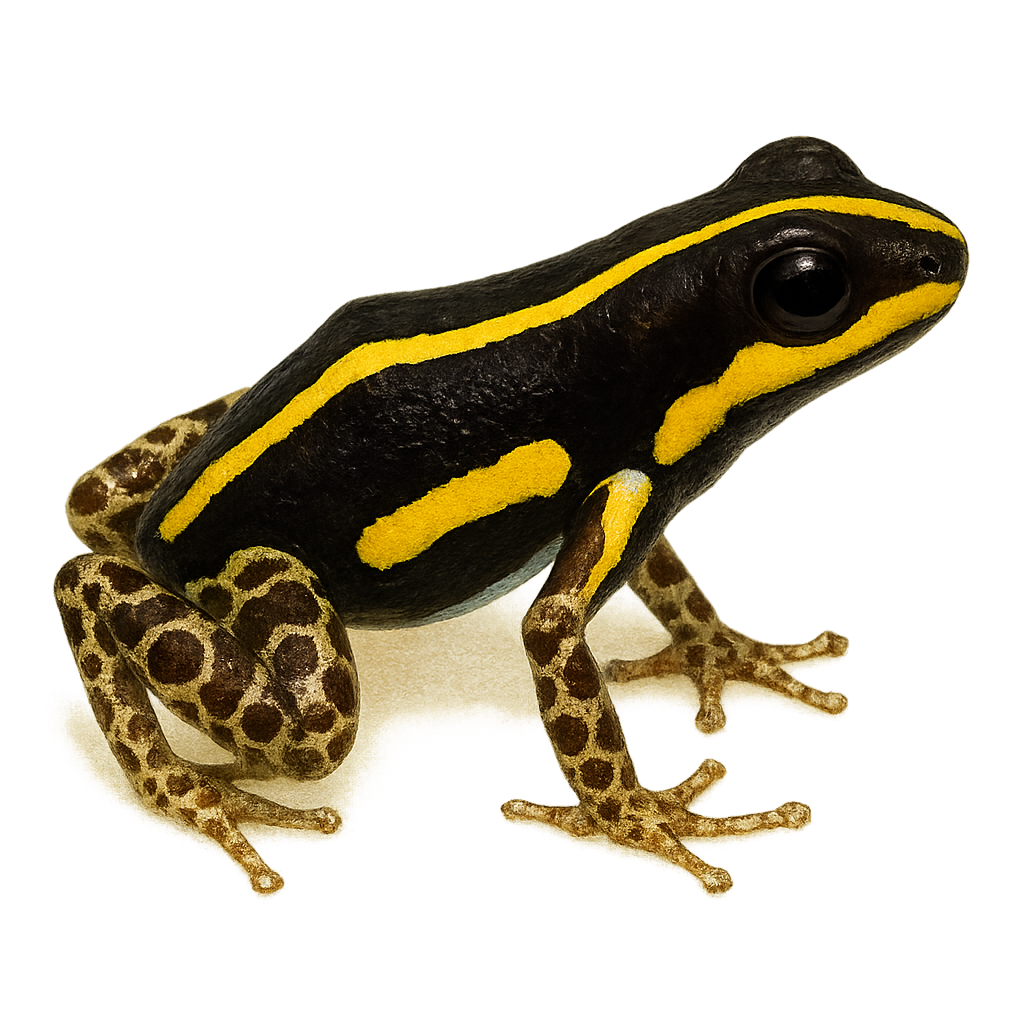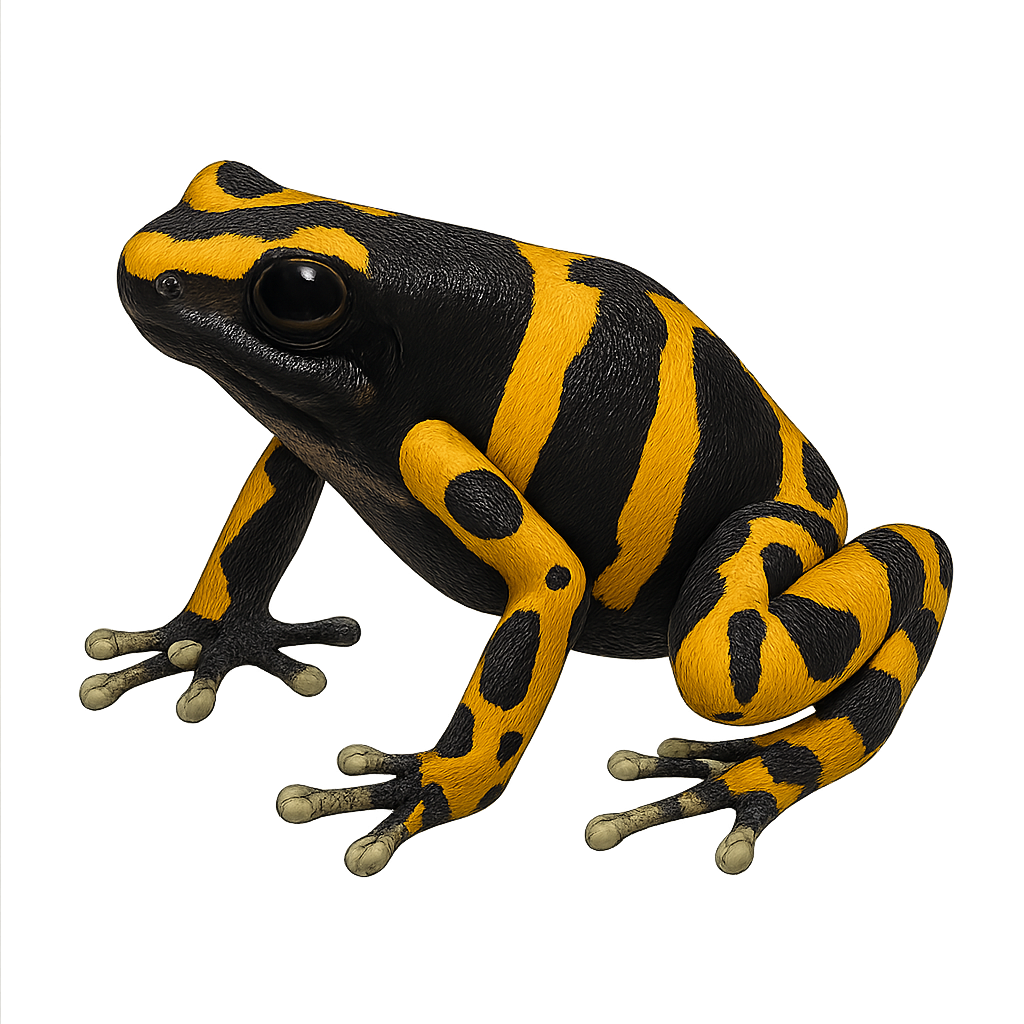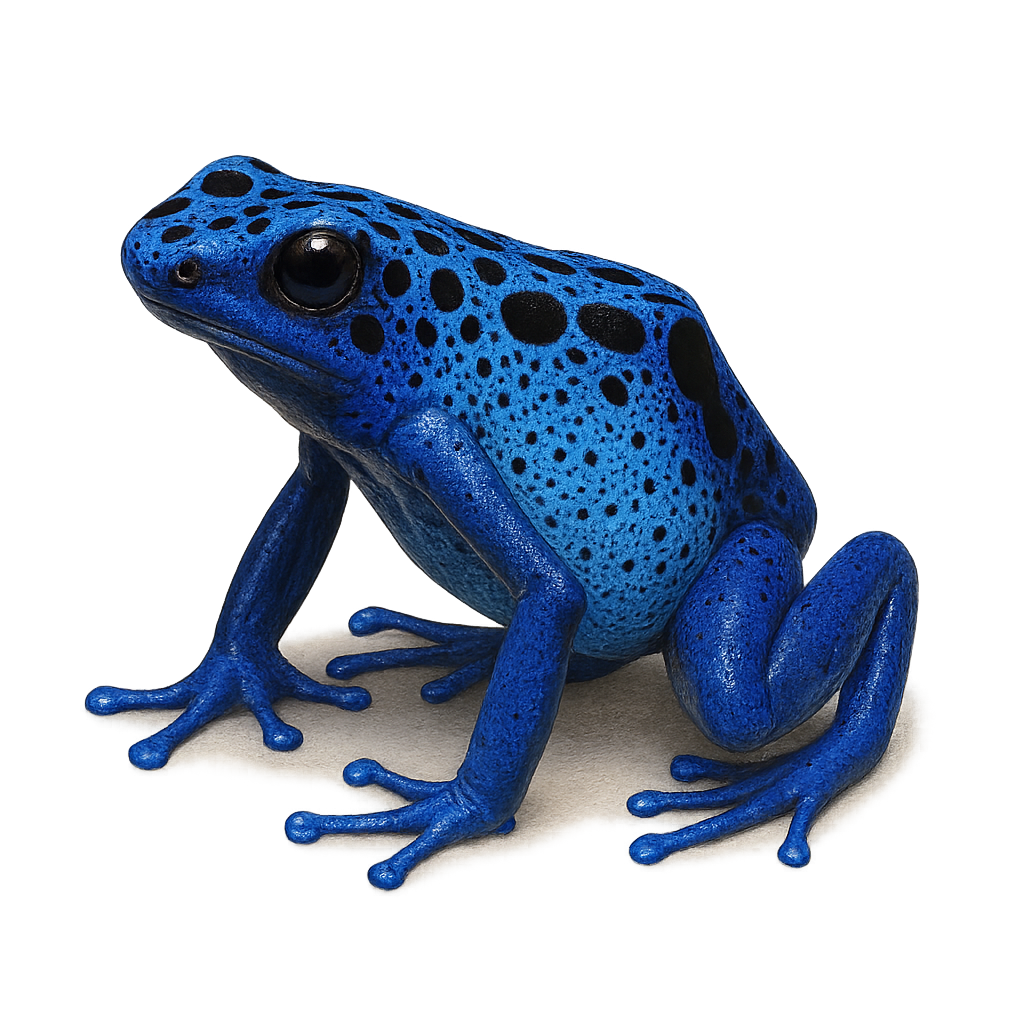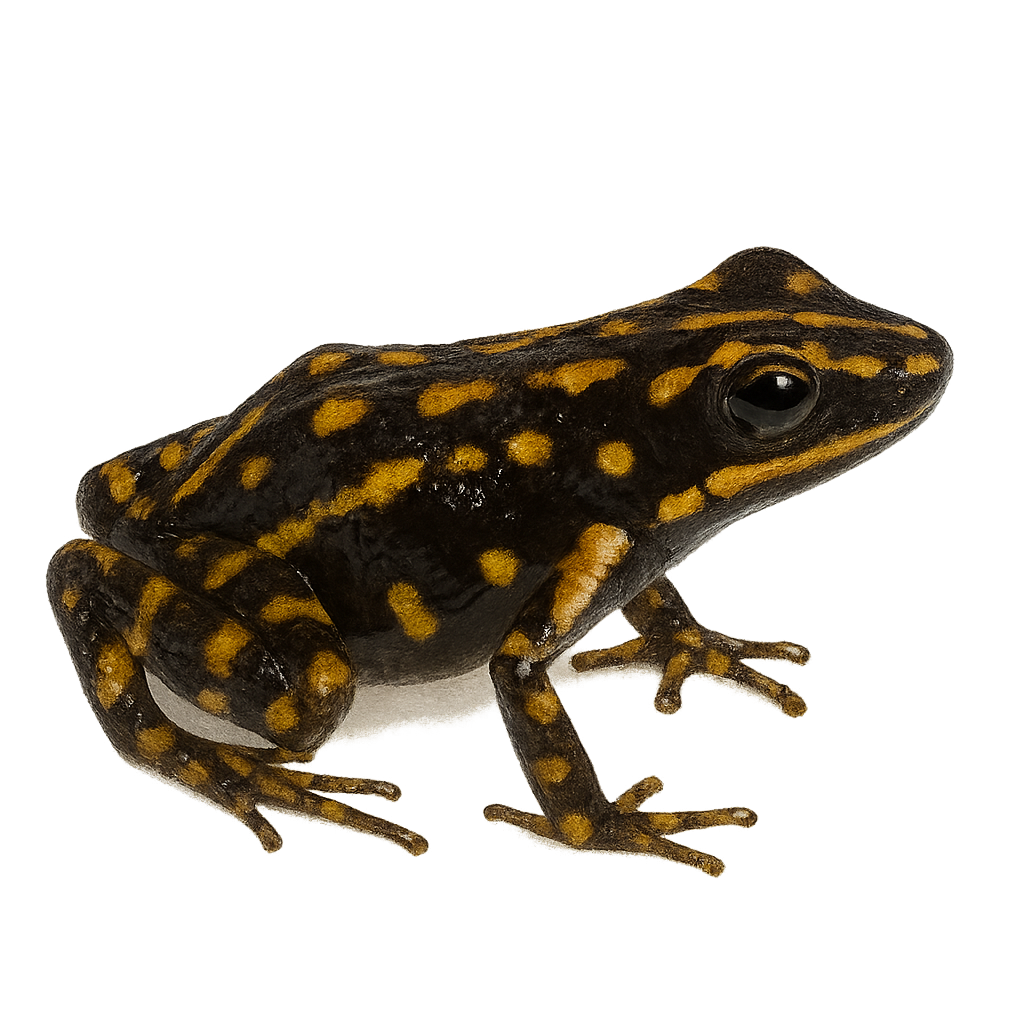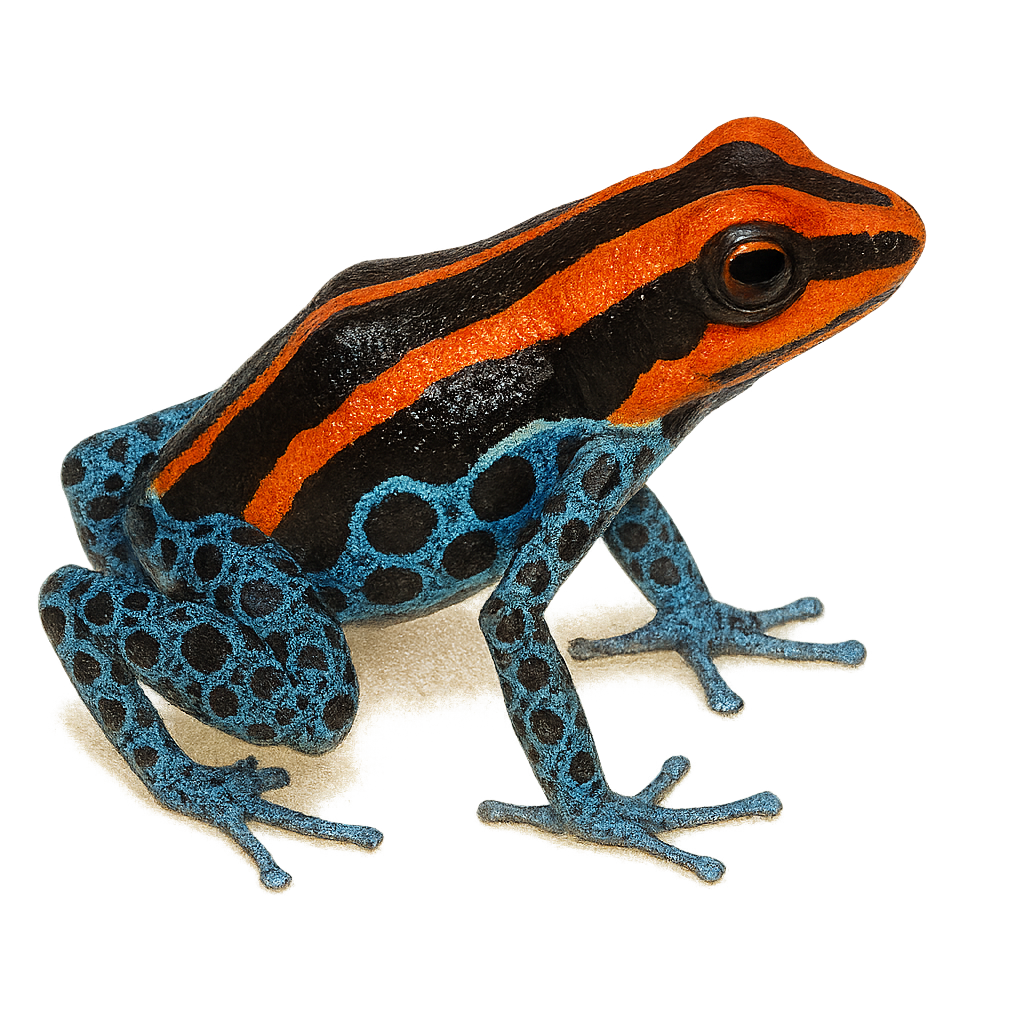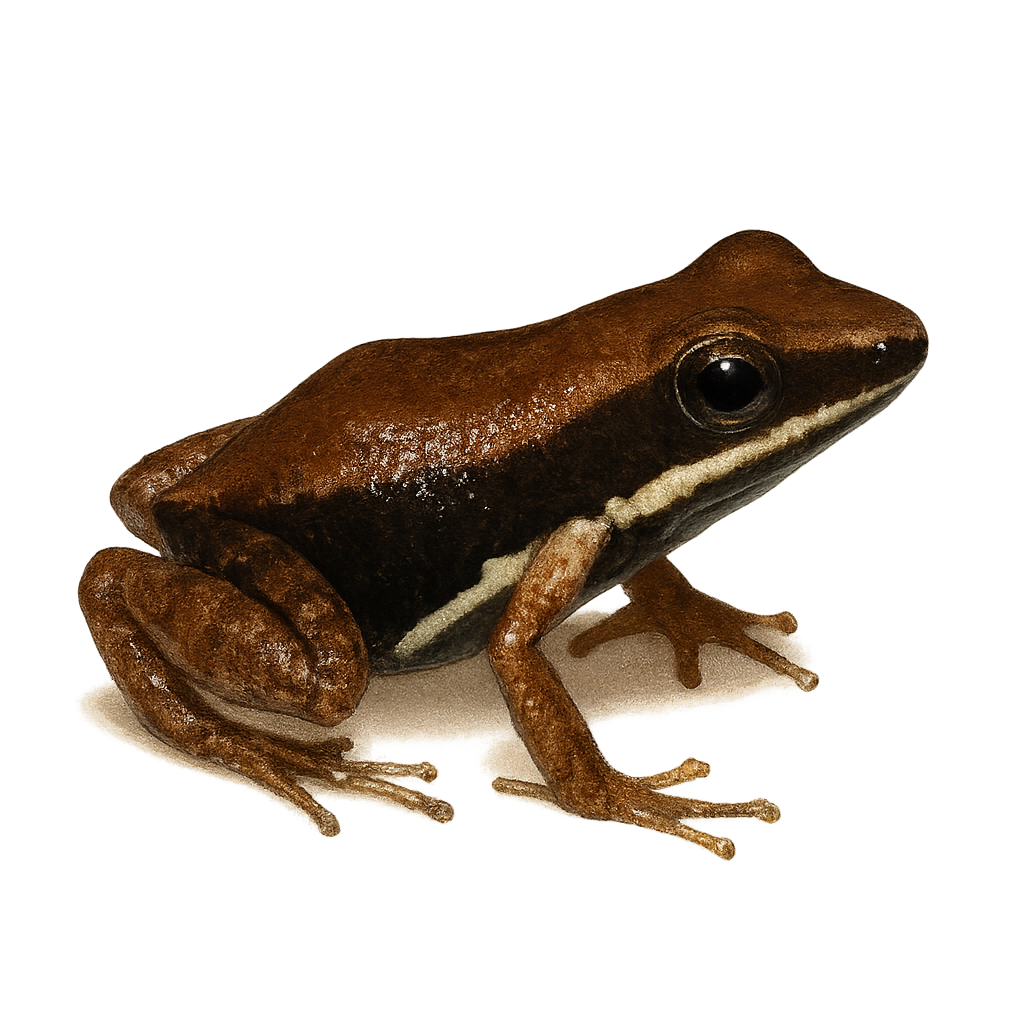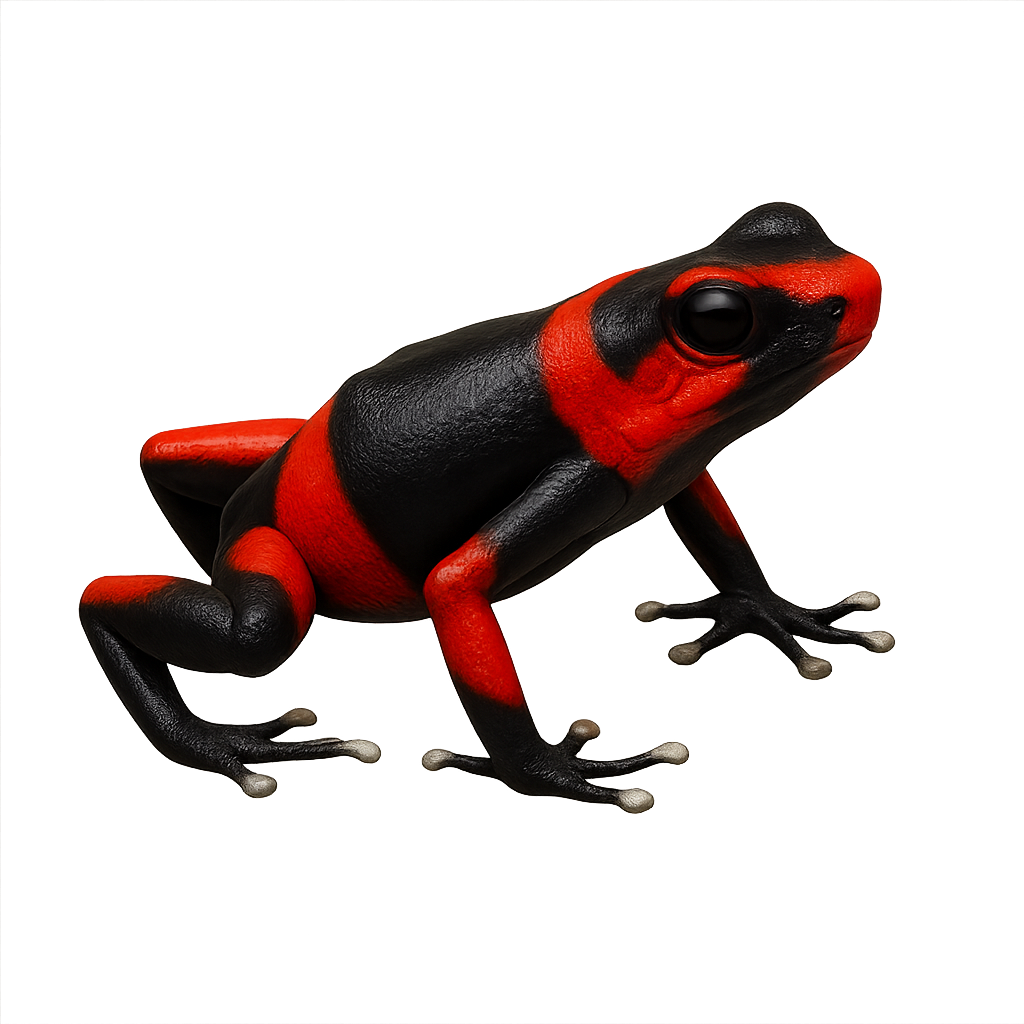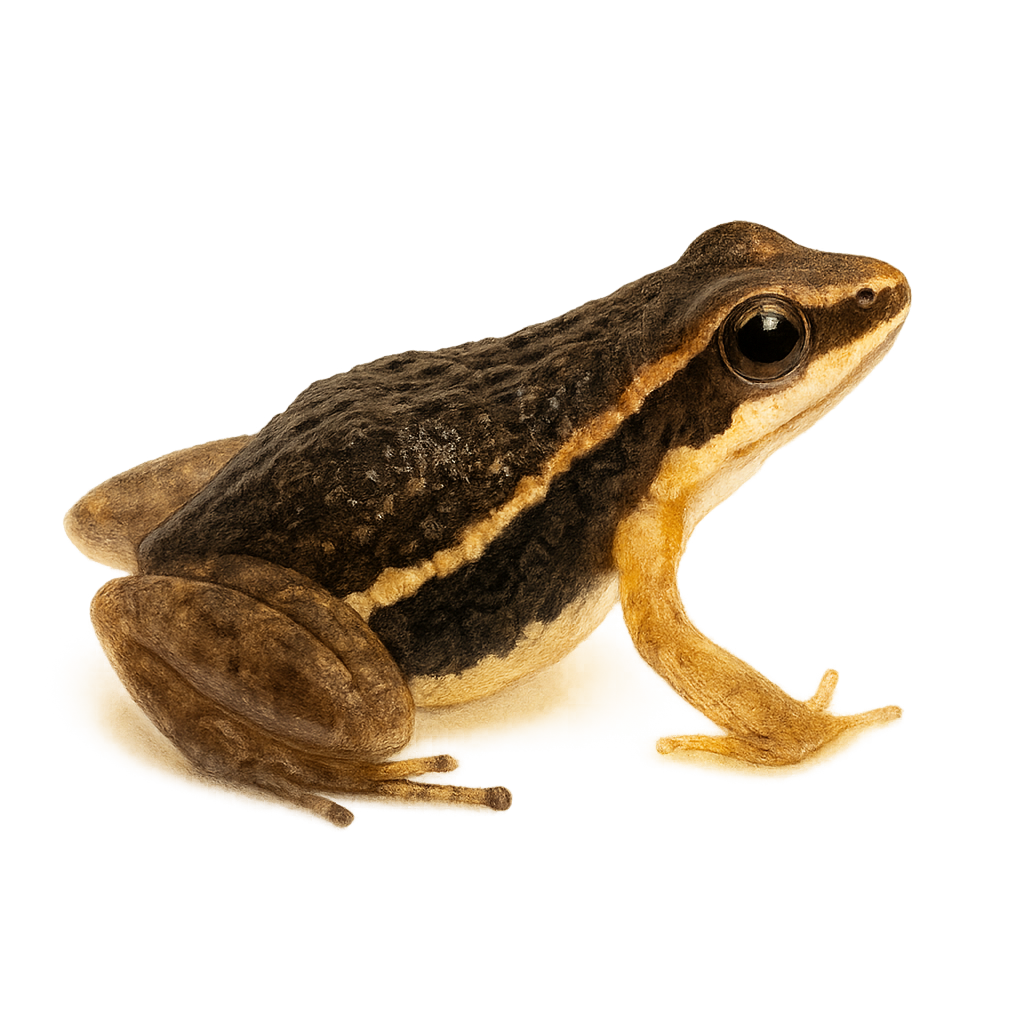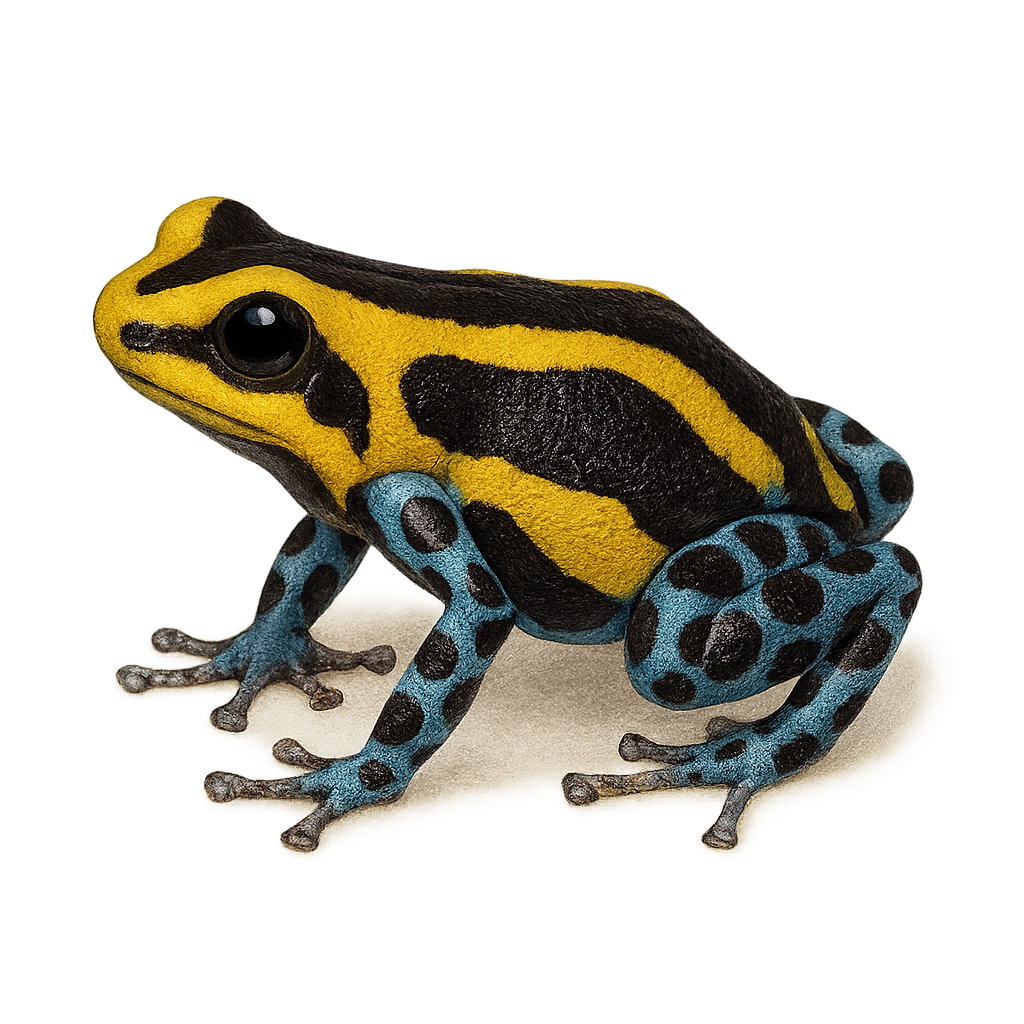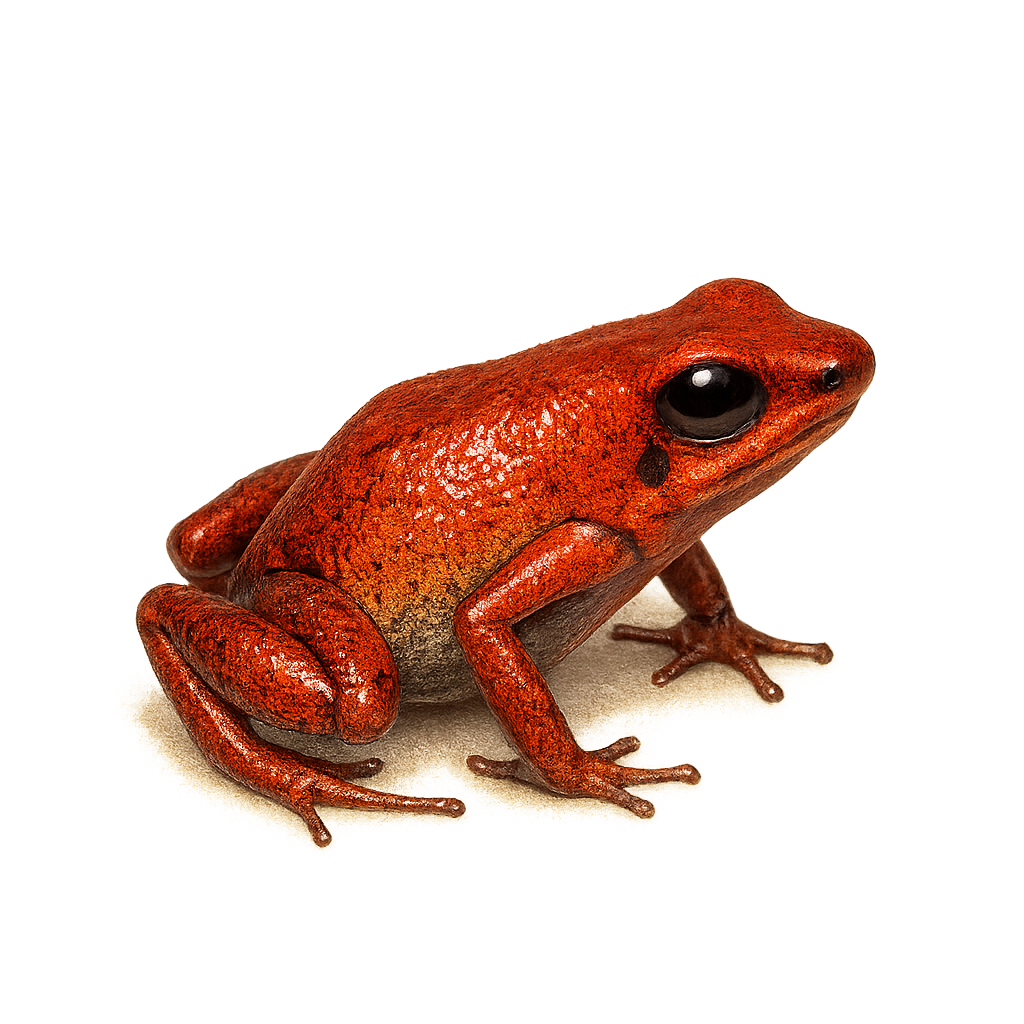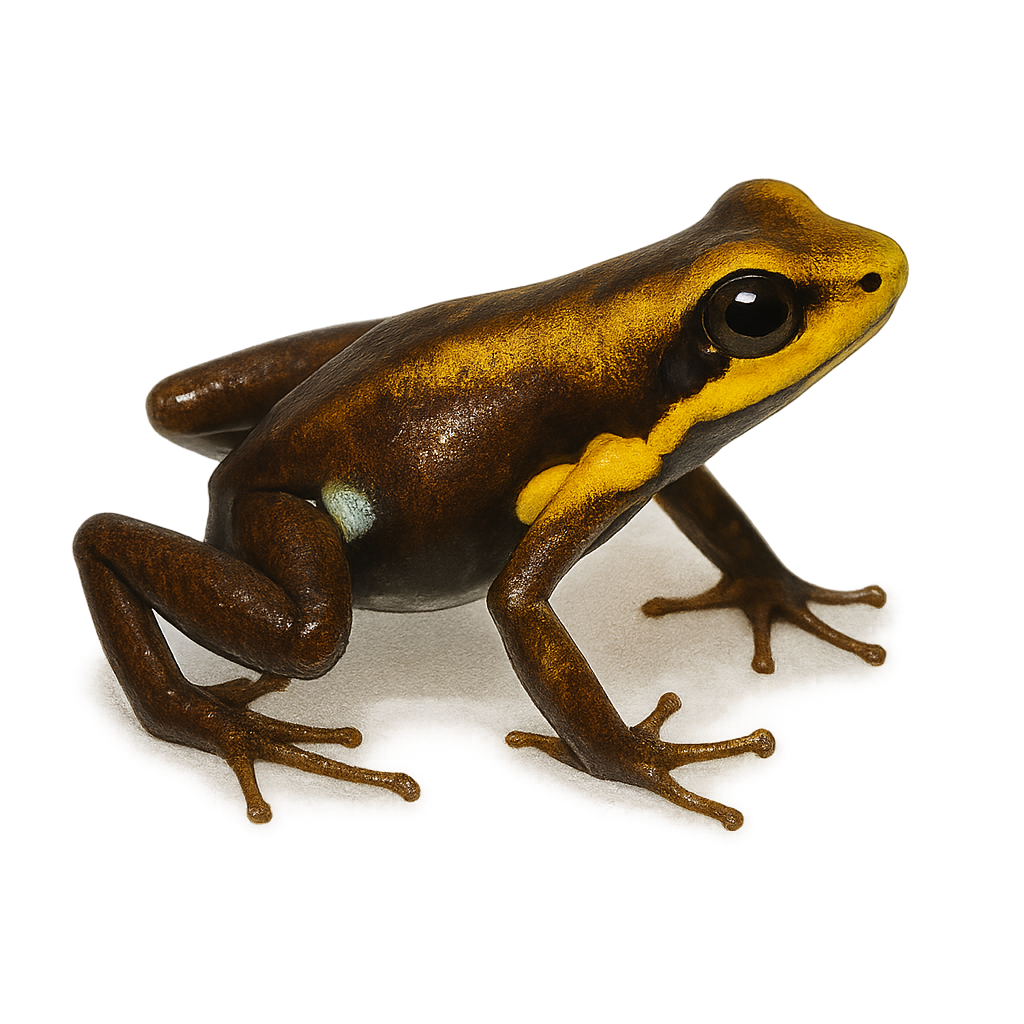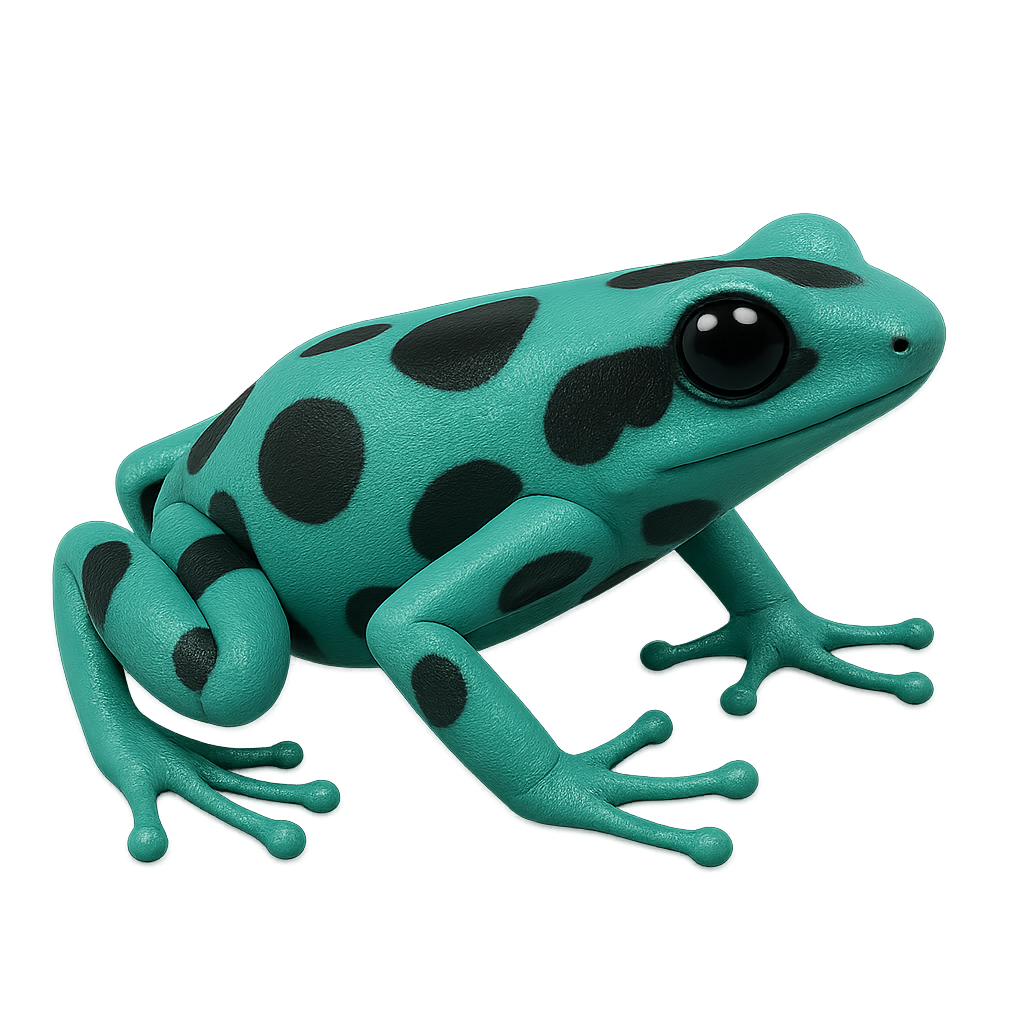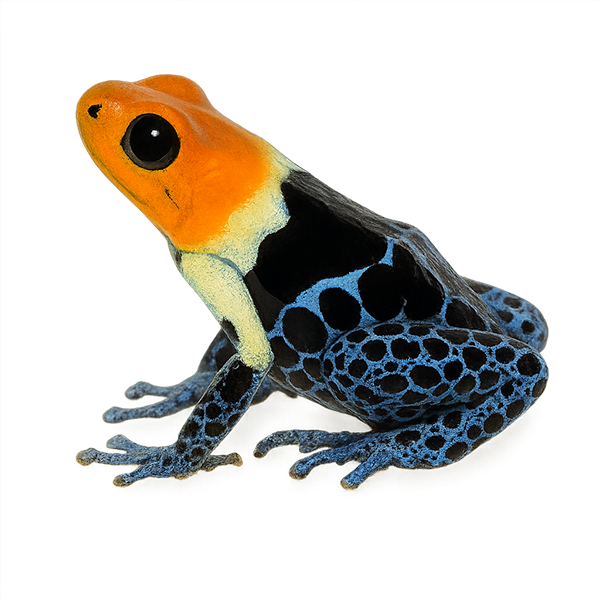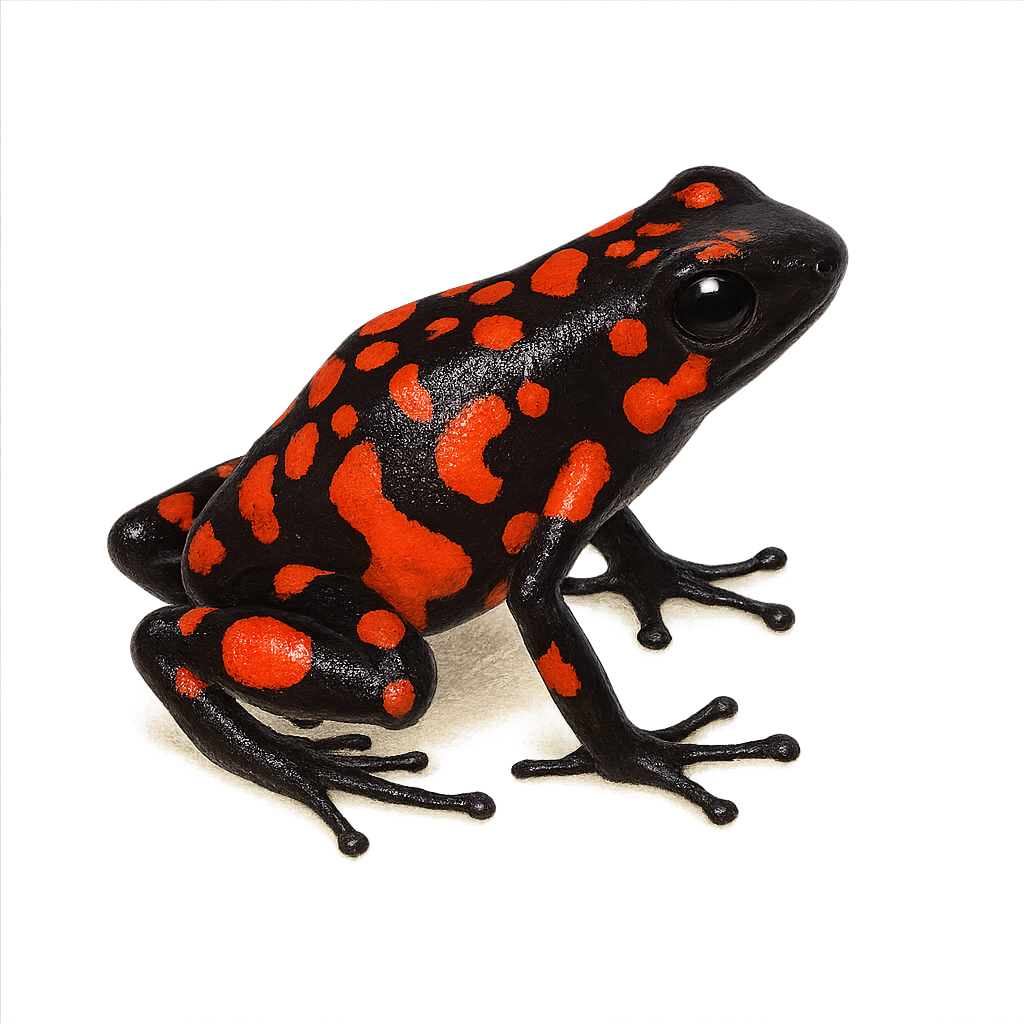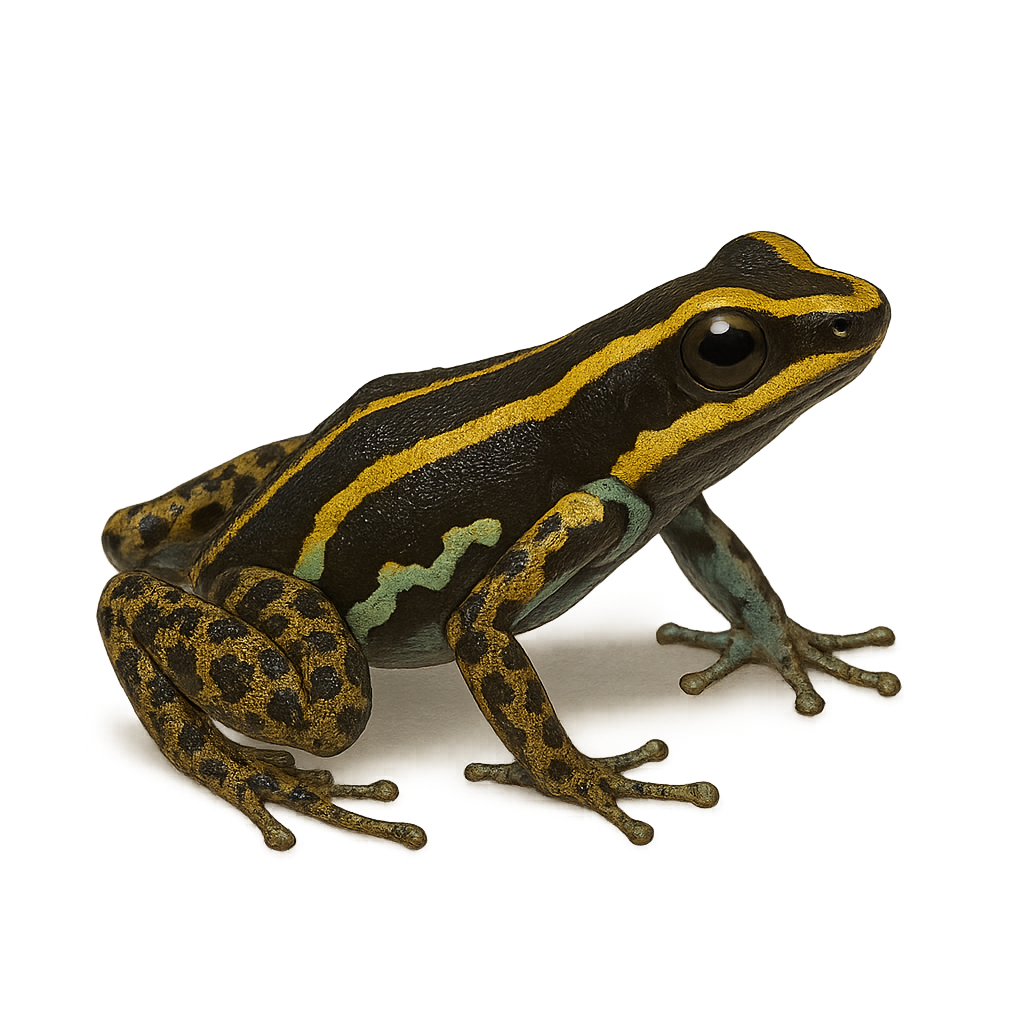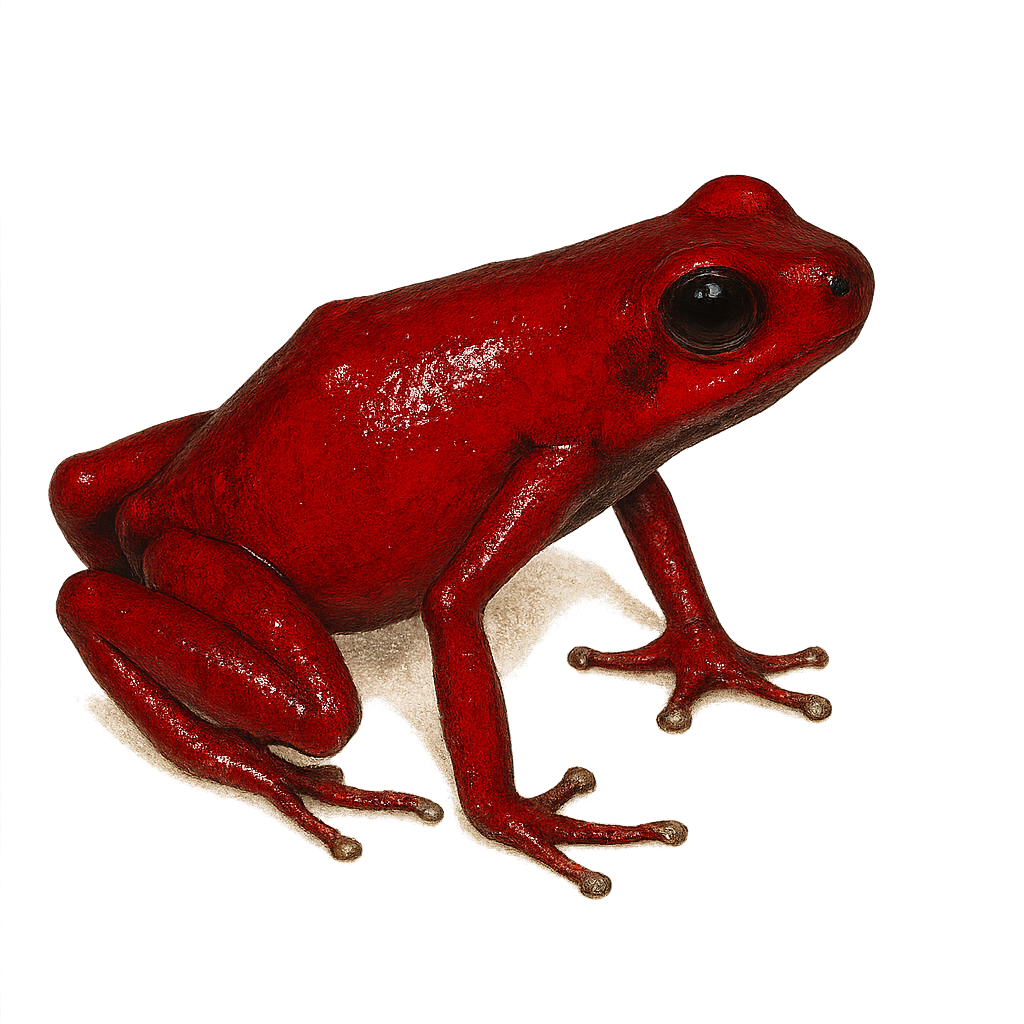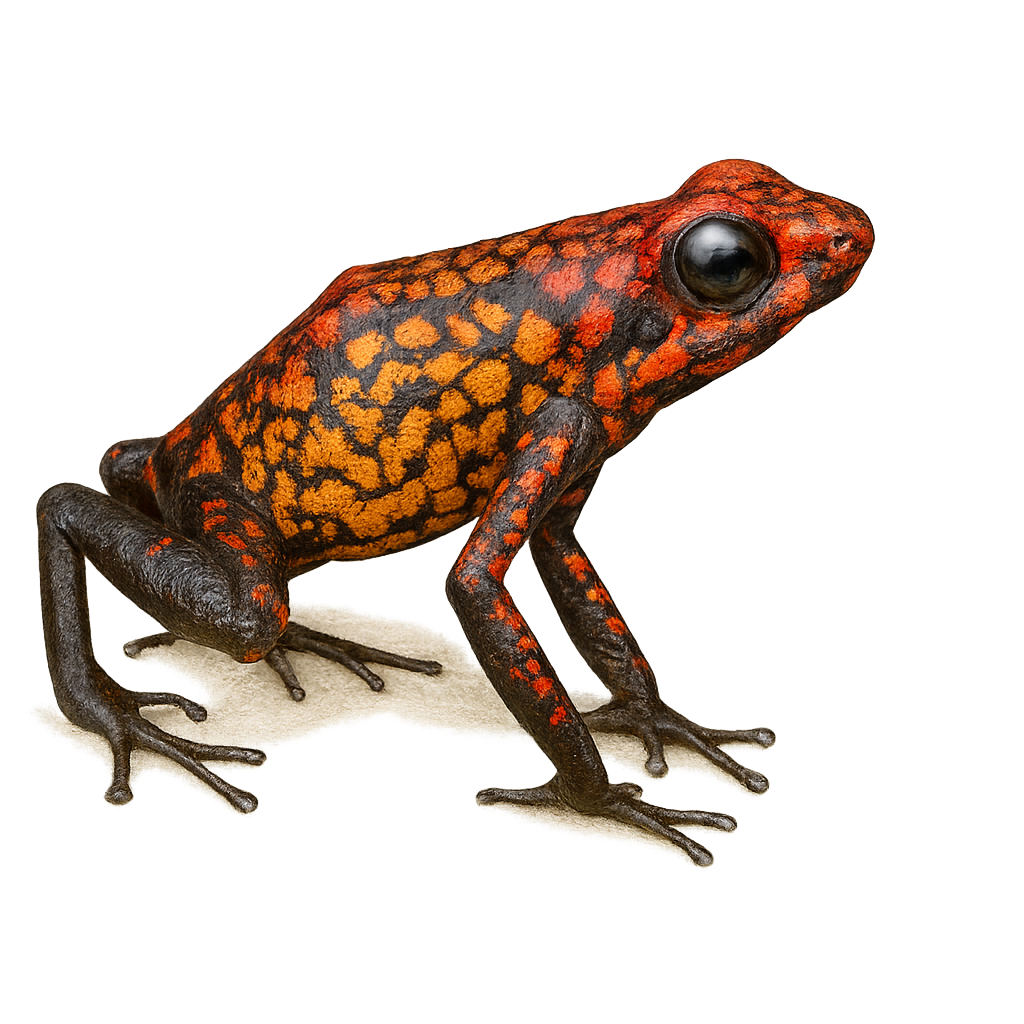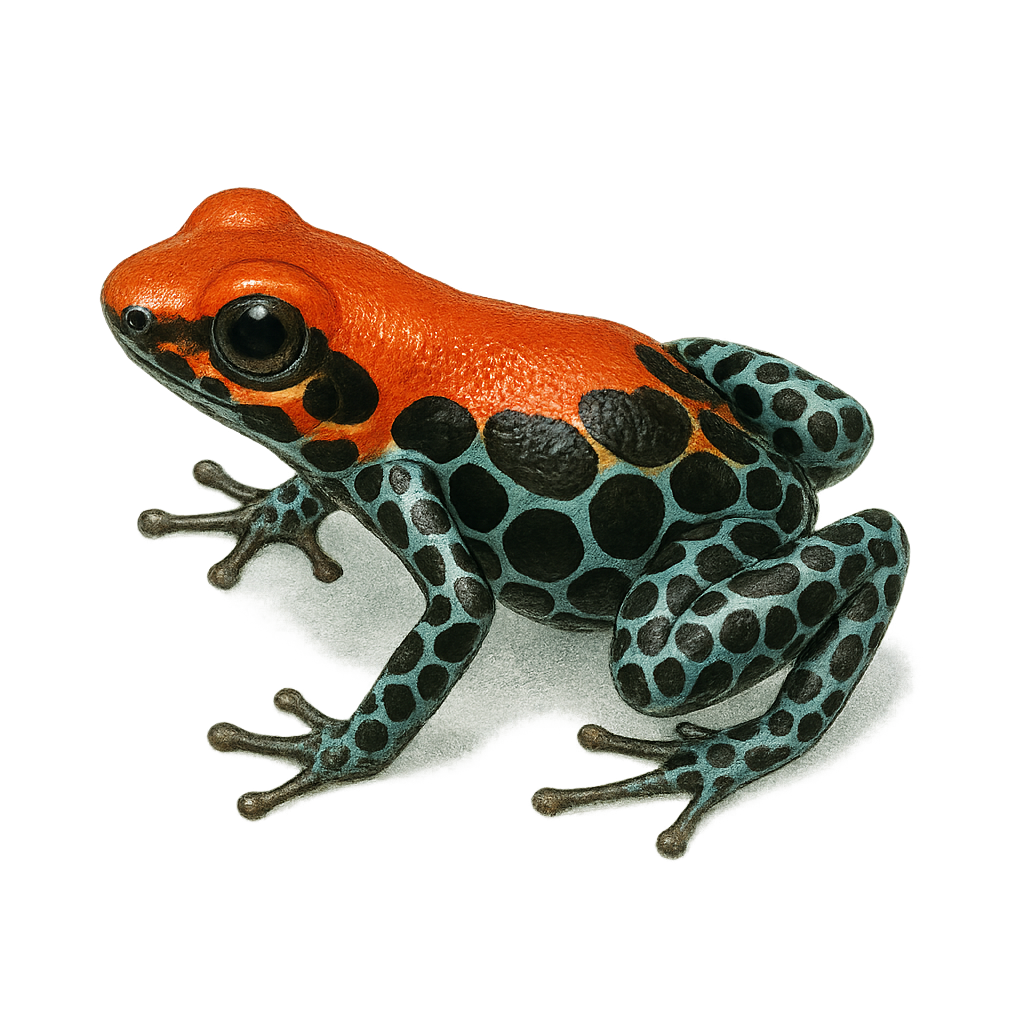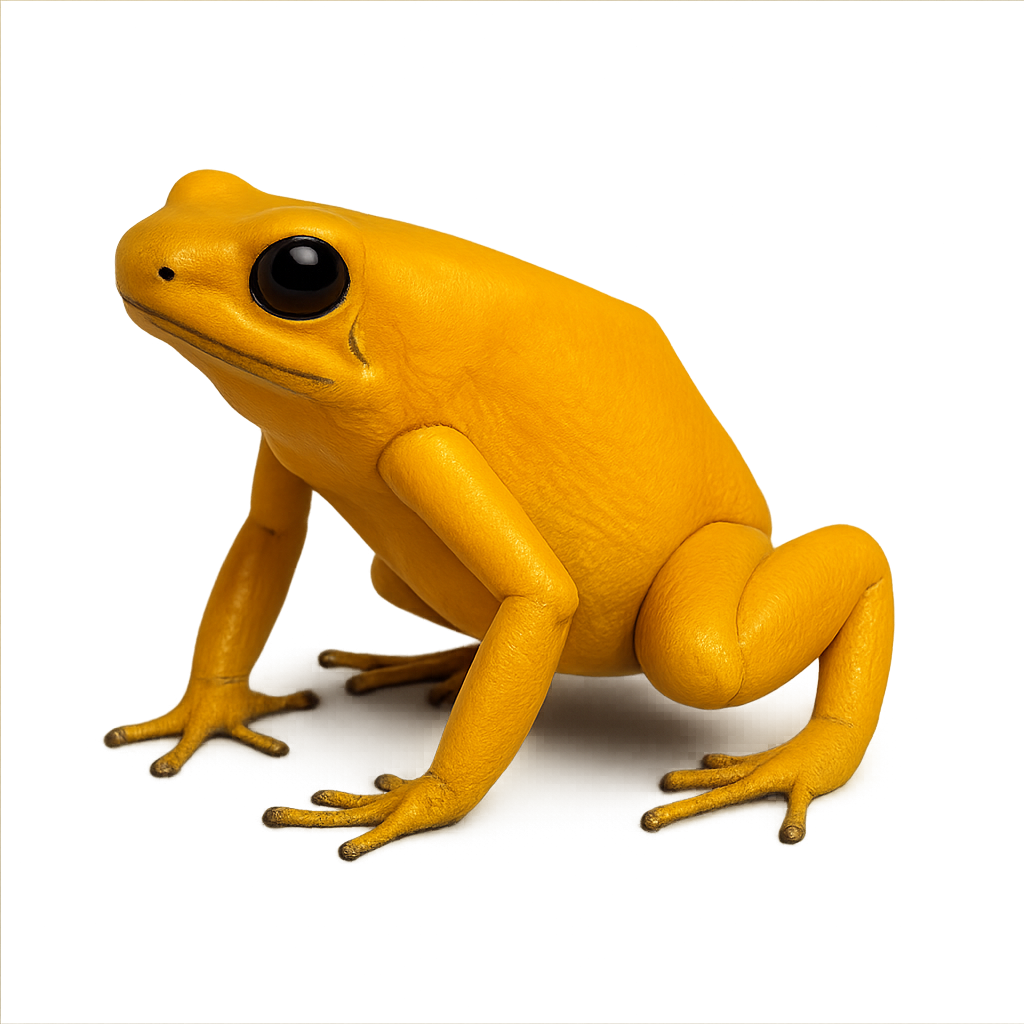The Dendrobatidés, belonging to the Dendrobatidae family, is a small frog known for its bright colors and toxic behavior. These frogs typically measure between 2 and 6 centimeters in length and are easily recognizable by their shiny, colorful skin, which can be yellow, blue, red, or green, depending on the species. They are primarily found in the humid tropical forests of Central and South America. Their diet consists of insects, small arthropods, and occasionally small worms. Dendrobatidéss are known for their toxic secretions, which serve as defense against predators. These toxins mainly come from their diet, particularly ants and beetles that contain alkaloids. Dendrobatidéss are also both terrestrial and aquatic creatures, typically laying their eggs in humid places, where their tadpoles develop in small pools of water or decaying leaves. Although fascinating, Dendrobatidéss are vulnerable to habitat loss due to deforestation and pollution.
Ranitomeya flavovittata is a small, brightly colored frog native to the rainforests of South America, primarily in Peru. It is known for its distinctive yellow stripes on a black background, making it easily recognizable. This species belongs to the Dendrobatidae family, known for its poisonous frogs. Although modest in size, typically between 1.5 and 2 cm, it plays a crucial role in the ecosystem as an insect predator. It prefers humid habitats, often near water bodies, and is primarily active during the day. Its skin secretes toxic alkaloids, an effective defense against predators. However, in captivity, it loses this toxicity due to the absence of its natural diet.
The Yellow-banded Poison Dart Frog, or Dendrobates leucomelas, is a small, vividly colored frog native to the humid tropical forests of Venezuela, Guyana, and Brazil. It is easily recognizable by its bright yellow bands contrasting with its black body. This coloration serves as a warning to potential predators of its toxicity. Measuring about 3 to 4 cm in length, this species is diurnal and primarily feeds on small insects. It plays a crucial role in the ecosystem by regulating insect populations. Although its skin is toxic, it is prized by terrarium enthusiasts for its striking colors and fascinating behavior.
The Amazonian Poison Frog, Ranitomeya amazonica, is a small, brightly colored frog native to the Amazon rainforest. Known for its vivid colors, often a mix of blue, black, and yellow, it warns predators of its toxicity. This species typically measures between 15 and 20 mm in length. It primarily inhabits humid tropical forests, feeding on small insects. Amazonian Poison Frogs are diurnal, active mainly during the day. Their reproduction involves laying eggs in aquatic microhabitats, often in bromeliads. Although their conservation status is not of concern, habitat destruction remains a potential threat.
The Blue Poison Dart Frog, scientifically known as Dendrobates azureus, is a small, brightly colored frog native to the rainforests of Suriname. Its vivid blue skin is dotted with black spots, making it easily recognizable. This bright coloration serves as a warning to potential predators, as it secretes potent toxins through its skin. Measuring about 3 to 4 cm in length, this species is diurnal and spends most of its time hunting small insects. It is often found in humid areas, near streams and ponds. Although its natural habitat is limited, it is popular in the pet trade, leading to conservation efforts to protect its wild populations.
The Anthony's Poison Arrow Frog, or Epipedobates anthonyi, is a small, brightly colored frog native to the humid tropical forests of Ecuador and Peru. Known for its vivid and toxic skin, it serves as a defense mechanism against predators. Measuring about 2 to 3 cm, this frog displays bright color patterns, often red and green, warning of its toxicity. It primarily inhabits moist undergrowth and feeds on insects and other small invertebrates. Although its population is stable, it faces threats from deforestation and habitat loss. Its reproduction involves eggs laid on the ground, which males then transport to water bodies for hatching.
The Espinoza's Poison Frog is a small, brightly colored frog endemic to the humid tropical forests of Ecuador. It is characterized by its smooth skin and vivid patterns, often red or orange with black spots. These bright colors serve as a warning to potential predators, indicating its toxicity. It typically measures between 2 and 3 cm in length. This species is diurnal and primarily feeds on small insects. It plays a crucial role in the ecosystem by regulating insect populations. Unfortunately, it is threatened by deforestation and habitat loss. Conserving its natural habitat is essential for its survival.
Ranitomeya benedicta is a small, brightly colored frog native to the humid rainforests of Peru. Known for its vivid colors, ranging from blue to black with yellow or orange patterns, it serves as a warning to potential predators of its toxicity. This species primarily inhabits dense, moist undergrowth, where it feeds on small insects. It is diurnal and spends most of its time foraging or hiding among leaves. Reproduction typically occurs during the rainy season when conditions are optimal for tadpole development. Eggs are laid in moist locations, and tadpoles are transported by parents to water bodies.
Marbled poison frog is a small, brightly colored frog native to the humid tropical forests of South America, mainly in Ecuador and Colombia. It is easily recognizable by its smooth skin and vivid patterns of red, orange, and black. This species is known for its toxicity, producing potent alkaloids that deter predators. It typically inhabits moist undergrowth, feeding primarily on small insects. Males are territorial and use vocalizations to attract females and ward off rivals. Reproduction occurs in temporary aquatic environments, where tadpoles develop before becoming adult frogs.
The Sira Poison Frog, or Ranitomeya lamasi, is a small, brightly colored frog native to the humid tropical forests of Peru. It is distinguished by its striking patterns of bright colors, often a combination of black, yellow, and blue, which serve as a warning to potential predators of its toxicity. This species is typically found in lowland areas, where it inhabits leaf litter and areas near water bodies. Lamasi Poison Frogs are known for their territorial behavior and diurnal lifestyle. They primarily feed on small insects and other arthropods. Their reproduction involves parental care, with eggs laid on the ground and tadpoles transported on the backs of adults to water points.
The Lehmann's Poison Frog, or Oophaga lehmanni, is a species of frog endemic to Colombia, known for its bright coloration and distinctive patterns ranging from red to yellow. These vivid colors serve as a warning to potential predators of its toxicity. It primarily inhabits tropical rainforests, where it hides under leaves and fallen tree trunks. This species is threatened by habitat loss and the illegal pet trade. It plays a crucial role in its ecosystem by controlling insect populations. Conserving its habitat is essential for its survival.
The Machalilla Poison Frog is a small, brightly colored frog endemic to the humid forests of Ecuador. It is characterized by its smooth skin and vibrant color patterns, often red and black, which serve as a warning to potential predators of its toxicity. This species is typically found in the undergrowth, where it primarily feeds on small insects. It plays a crucial role in the ecosystem by controlling insect populations. Unfortunately, deforestation and habitat loss threaten its survival. Conservation efforts are essential to protect this unique species and its natural habitat.
The Sirena Poison Frog, Ranitomeya sirensis, is a small, brightly colored frog native to the humid tropical forests of Peru. Known for its vivid colors, which range from blue to black with yellow or red patterns, it serves as a warning to potential predators of its toxicity. Measuring about 2 cm in length, this species is diurnal and primarily feeds on small insects. It inhabits lowland areas, often near water bodies. Its skin secretes toxic alkaloids, used by local populations to poison arrows. Although its population is stable, it is threatened by deforestation and the illegal exotic pet trade.
The Steyermark's Poison Frog is a small, brightly colored frog endemic to the tropical forests of Venezuela. It is characterized by its vivid skin, often red or orange with black spots, which serves as a warning to potential predators due to its potent toxins. Measuring about 2 cm, it is primarily terrestrial and feeds on small insects. Its natural habitat is threatened by deforestation, making it a vulnerable species. It plays a crucial role in the ecosystem by controlling insect populations. Its reproduction is complex, involving parental care where tadpoles are transported on the adults' backs to water bodies.
The Summers' Poison Frog, or Ranitomeya summersi, is a small, brightly colored frog native to the tropical forests of Peru. It is known for its vivid colors, ranging from blue to black with yellow or orange patterns. This species is often found in humid areas and dense forests, where it hides under leaves and debris. It is diurnal and spends most of its time foraging for food, primarily insects. Due to its small size, it is vulnerable to predators, but its bright colors serve as a warning of its toxicity. Conservation of its natural habitat is crucial for its survival, as deforestation threatens its populations.
The Tolima Poison Frog, scientifically known as Andinobates tolimensis, is a small, brightly colored frog endemic to the tropical forests of Colombia. It is characterized by its smooth skin and vibrant colors, often a mix of red, orange, and black, which serve as a warning to potential predators of its toxicity. This species is typically found in humid undergrowth, where it primarily feeds on small insects. It plays a crucial role in the ecosystem by controlling insect populations. Unfortunately, due to deforestation and habitat loss, the Tolima Poison Frog is considered vulnerable. Conservation efforts are essential to protect this unique species and its natural habitat.
The Golden Poison Dart Frog is a small, vibrant, and colorful frog from the Dendrobatidae family. This species typically measures between 2 and 3 centimeters in length and is easily recognized by its golden skin, often speckled with black. It primarily inhabits the humid tropical forests of Central and South America, particularly in Costa Rica and Panama. The Golden Poison Dart Frog feeds mainly on small insects, ants, and mites. It is known for its toxicity, which comes from its diet, particularly from certain ants and beetles that contain alkaloids. These toxins serve as a defense mechanism against predators. This species is also known for its social behaviors and vocalizations during the breeding season. The eggs of the Golden Poison Dart Frog are laid on the forest floor, and the tadpoles develop in small pools of water or on decaying leaves. While this species is not currently endangered, it is threatened by deforestation and the destruction of its natural habitat.
The Ranitomeya fantastica, or fantastic poison frog, is a small, colorful frog native to the rainforests of Peru. Known for its striking patterns and vibrant colors, ranging from yellow to red, often with black spots, these frogs typically measure between 1.5 and 2 cm in length. They primarily inhabit humid undergrowth and feed on small insects. Their skin secretes toxic alkaloids, a natural defense against predators. Although fascinating, their habitat is threatened by deforestation, making them vulnerable. They play a crucial role in the ecosystem by controlling insect populations and serving as bioindicators of environmental health.

The Strawberry Poison Dart Frog is a small, vibrant, and colorful frog from the Dendrobatidae family. This species typically measures between 2 and 3 centimeters in length and is easily recognizable by its bright red or orange color, sometimes speckled with blue or black, hence its name "strawberry." It is primarily found in the humid tropical forests of Central America, particularly in Costa Rica and Panama. Its diet mainly consists of ants, spiders, and other small arthropods, which it primarily captures from the forest floor. The bright coloration of its skin is an indicator of its toxicity, which comes from alkaloids found in its diet, particularly ants. These toxins serve as protection against predators. During the breeding season, the Strawberry Poison Dart Frog lays its eggs on the forest floor or in humid areas where the tadpoles develop, often in small pools of water or tiny puddles. While this species is not in immediate danger, it is threatened by deforestation, habitat loss, and pollution.
The Harlequin Poison Frog is a small, brightly colored frog native to the humid tropical forests of Colombia. Known for its vivid and varied colors, ranging from red to yellow, blue, and black, it uses these as a warning to predators of its toxicity. This species typically measures between 2 and 4 cm in length. It primarily feeds on small insects and arthropods. The Harlequin Poison Frog is diurnal, spending most of its time foraging on the forest floor. Its skin secretes toxic alkaloids, which local populations have historically used to poison hunting darts. This species is threatened by habitat loss and the illegal exotic pet trade.
The Lovely Poison Frog is a small, diurnal terrestrial frog, measuring about 2.5 cm in length. Its body is black with two bright yellow to orange longitudinal stripes on the back, and blue-green marbling on the flanks and limbs. This species inhabits lowland humid forests, often near slow-moving streams, between 10 and 650 m elevation. It primarily feeds on small invertebrates such as ants and spiders. Although its skin contains toxic alkaloids, including batrachotoxins, their concentration is low and sometimes undetectable. The Lovely Poison Frog is listed as Least Concern by the IUCN, but is locally threatened by deforestation and pollution.
The Splendid Poison Frog, Oophaga speciosa, is a tree-dwelling frog species known for its vibrant and toxic skin. Native to the humid rainforests of Central America, it is distinguished by its bright colors ranging from vivid red to deep blue, a warning to predators of its toxicity. This frog typically measures between 2 and 4 cm in length. It primarily feeds on small insects and arthropods. Males are territorial and use vocal calls to attract females and deter rivals. Reproduction involves parental care, with eggs laid on the forest floor and tadpoles transported on the adults' backs to water bodies.
The Hidden poison frog, Oophaga occultator, is a fascinating species from the Dendrobatidae family, known for its bright colors and discreet behavior. It primarily inhabits the humid tropical forests of Colombia, often hiding among leaf litter and mosses. This small frog typically measures between 2 and 3 centimeters. It is distinguished by its ability to produce powerful skin toxins, used as a defense mechanism against predators. Due to its limited habitat and increasing deforestation, it is considered vulnerable. Its reproduction is complex, involving parental care where adults transport tadpoles to secure aquatic sites.
The Ranitomeya reticulata, commonly known as the reticulated poison frog, is a small, brightly colored frog native to the humid rainforests of South America, particularly in Peru and Ecuador. It is renowned for its vibrant skin, featuring a complex pattern of black reticulations on a bright yellow or orange background, making it a fascinating specimen for herpetologists and frog enthusiasts. This species is diurnal and primarily feeds on small insects and arthropods. Although its skin is toxic, it poses no threat to humans unless handled improperly. The Ranitomeya reticulata plays a crucial role in its ecosystem by regulating insect populations and serving as prey for certain predators.
The Dendrobates tinctorius, also known as the Blue Poison Dart Frog, is a vibrant species of toxic frog native to the humid tropical forests of South America, primarily in Guyana, Brazil, and Suriname. This frog is easily recognizable by its bright blue color, which serves as a warning to predators of its toxicity. Dendrobates tinctorius are primarily insectivorous and feed on small insects. Their bright color comes from the toxins of the insects they consume in their natural habitat. In captivity, they are not toxic as their diet changes. This frog is also known for its discreet behavior and primarily nocturnal habits.
The Golden poison dart frog, also known as the Terrible Dart Frog, is considered one of the most toxic animals in the world. Native to the tropical forests of Colombia, this small frog is distinguished by its bright yellow color, which serves as a warning to predators of its toxicity. It derives its toxin from its diet, primarily consisting of insects found in its natural habitat. These frogs are not toxic in captivity as their diet changes. Despite its toxicity, it has been used by some cultures to poison the tips of their arrows, earning it the name 'poison dart frog.'
The Phantasmal Poison Frog, or Epipedobates tricolor, is a small, brightly colored frog native to the humid tropical forests of Ecuador. Known for its vivid colors ranging from red to green and yellow, it uses these hues as a warning to potential predators of its toxicity. This diurnal species primarily feeds on small insects and is often seen on the forest floor, where it blends in with the fallen leaves. Despite its small size, it plays a crucial role in the ecosystem by controlling insect populations. Unfortunately, it is threatened by deforestation and habitat loss.
The Doris Swanson's Poison Frog, Andinobates dorisswansonae, is a fascinating species from the Dendrobatidae family. Endemic to the humid rainforests of Colombia, it primarily inhabits dense undergrowth and areas near water streams. This small frog, measuring about 2 cm, is renowned for its bright coloration, ranging from yellow to red, serving as a warning signal to potential predators. Indeed, it secretes powerful toxins through its skin, a common trait among poison frogs. Its behavior is generally suspicious, making it difficult to observe in its natural habitat. It plays a crucial role in the ecosystem by regulating insect populations. Unfortunately, it is threatened by deforestation and habitat loss.
The green tree frog, Hyla cinerea, is a small arboreal frog native to North America. It is characterized by its bright green color, sometimes adorned with white or golden spots. Its skin is smooth, and it has long limbs adapted for climbing. Measuring about 4 to 6 cm, it is often found near stagnant water bodies like marshes and ponds. Primarily nocturnal, it emits a distinctive call during the breeding season. Although common, it is sensitive to environmental changes, particularly water pollution and habitat destruction.
The Corsican Mountain Newt, Euproctus montanus, is an endemic species of the island of Corsica. It is characterized by its smooth skin and brownish coloration, often speckled with darker spots. Typically measuring between 10 and 15 cm, it primarily inhabits clear streams and wet areas of the Corsican mountains. This species is well adapted to cool and humid environments and is often found at altitudes between 600 and 2000 meters. The Corsican Mountain Newt is an important indicator of water quality, as it is very sensitive to pollution. Unfortunately, it is threatened by habitat degradation and climate change.


